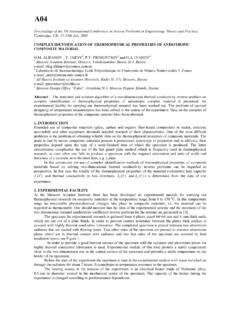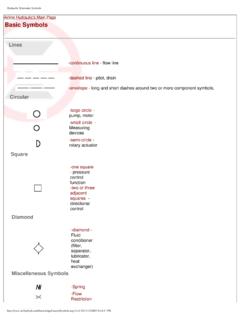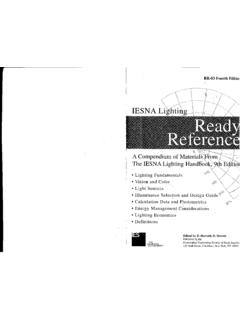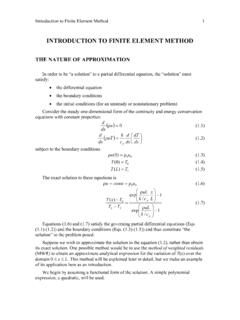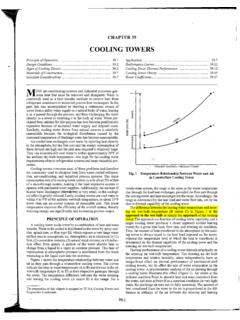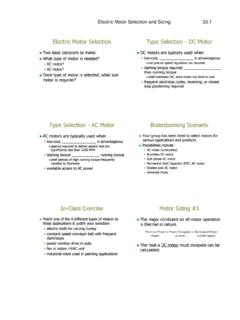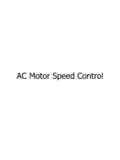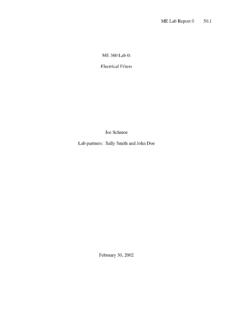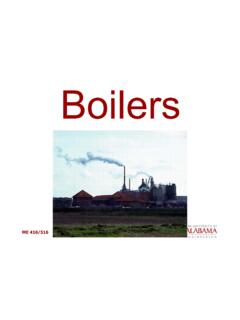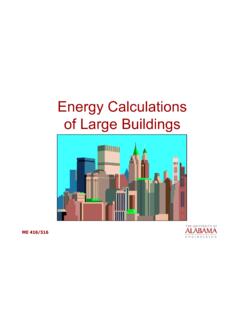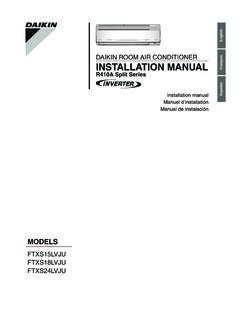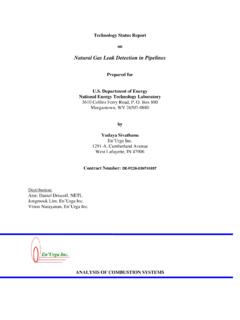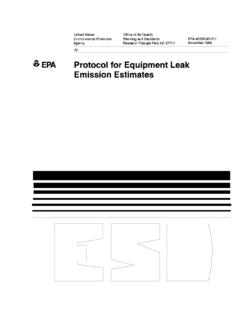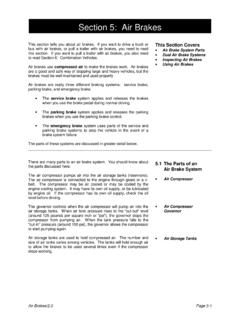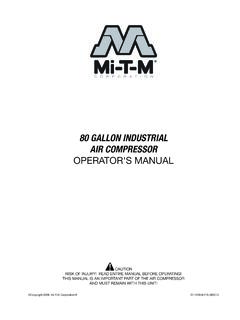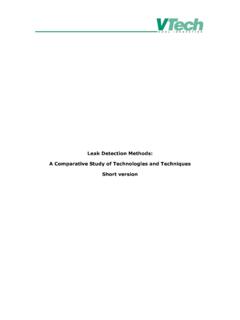Transcription of Air Compressors - University of Alabama
1 Air Compressors Two Types Positive Displacement Reciprocating Rotary Screw Dynamic Centrifugal Axial flow Rotary Screw Compressors Rotary Screw Compressors Direct Injection , Oil-injected , Direct-cooled , Flooded Various names are suggestive of the direct contact of lubricating/cooling oil onto the rotating screw parts Requires a separator just after compression to remove oil from the compressed air Oil-free , Oil-less , Dry Compressors also available (food industry, hospitals, etc.) Animations Due to overlapping and continuous compression cycles, the rotary screw design generates virtually no vibration. Disturbing noise is minimized, providing a wider choice for the unit's location on the vehicle. The ends of the rotors uncover the inlet: air enters the compression chamber.
2 The air is entrapped in the 'compartment' formed by a male lobe and a female flute. As the rotors turn, the compartment becomes progressively smaller, thereby compressing the entrapped air. Compressed air leaves through the outlet port Centrifugal Compressors Centrifugal Compressors Compressor Controls On/Off (Start/Stop) Modulated Load/Unload Variable Displacement Variable Speed Drive (VSD) 100200300400500600 Tue 01:00 Tue 02:00 Tue 03:00 Tue 04:00 Tue 05:00 Tue 06:00 Tue 07:00 Tue 08:00 Tue 09:00 Tue 10:00 Tue 11:00 Tue 12:00 Tue 13:00 Tue 14:00 Tue 15:00 Tue 16:00 Tue 17:00 Tue 18:00 Tue 19:00 Tue 20:00 Tue 21:00 Tue 22:00 Tue 23:00 Wed 00:00 AmpsInterval data (4 seconds) for System (Not Assigned) and Periods (Not Assigned)12/15/2008 11:54:06 PM to 12/17/2008 12:32:05 AMCurr_250_hp_rent (Amps) Curr_250_hp (Amps) Curr_100_hp (Amps) 010020030040010:24:2010:24:4010:25:0010: 25:2010:25:4010:26:0010:26:2010:26:4010: 27:0010:27:2010:27:4010:28:0010:28:2010: 28:4010:29.
3 0010:29:2010:29:4010:30:0010:30:2010:30: 4010:31:0010:31:2010:31:4010:32:0010:32: 2010:32:4010:33:00 AmpsInterval data (4 seconds) for System (Not Assigned) and Periods (Not Assigned)12/16/2008 10:24:15 AM to 12/16/2008 10:33:08 AMCurr_250_hp_rent (Amps) Curr_250_hp (Amps) Curr_100_hp (Amps) Typical Compressor Controls/Characteristics 0102030405060708090100050100 Power, percent of full loadCapacity (Flow), percentStart/Stop)(Load/Unload)ModMod/Un loadCompressors - Saving Energy Reduce run time turn off when not needed Lower system pressure to lowest possible level Repair leaks Recover waste heat Additional system volume (load/unload only) Reduce use of pneumatic tools Lower Pressure Rule of thumb: For systems in the 100 psig range, every 2 psi decrease in discharge pressure results in approximately 1 percent power decrease at full output flow Lower Pressure Unregulated Usage Rule of thumb: For systems with 30 to 50 percent unregulated usage, a 2 psi decrease in header pressure will decrease energy consumption by about to percent because of unregulated air Total is to 2% power decrease for every 2 psi drop Lower Pressure Calculations Estimate annual energy usage (assume compressor runs fully loaded unless you know otherwise) KWh = HP/ m x x LF x H Compute reductions.
4 Every 2psi reduction is a to reduction in power, so each 2psi reduction gives to of the previous value kWhnew=kWhold x (1 PCT ) P/2 kWholdx(1 -PCTx P/2) Example Reduce Pressure A 150hp compressor runs 90% loaded 12 hours per day 5 days per week at a delivery pressure of 110psi. Estimate the energy and cost savings if the pressure is reduced to 90psi. Assume $ for electricity and the motor is 95% efficient Solution: Assume a reduction for every 2psi to account for unregulated usage. First estimate the annual energy usage: Example/Solution Reduce Pressure kWh= HP / mx x LF x H = 150 x x x 3120 hrs = 330,753 kWh/yr Compute reductions kWhnew = 330,753 kWh x ( 1 ) 20/2 = 275,816 kWh Energy Savings are 54,937 kWh/yr Net reduction is At $ , this amounts to $2,747 / yr Reduce Air Leaks A typical plant that has not been well maintained will likely have a leak rate equal to 20 percent of total compressed air production capacity.
5 Proactive leak detection and repair can reduce leaks to less than 10 percent of compressor output Reduce Air Leaks Calculations Savings realized depend on the type of compressor controls Input power decreases linearly with decrease in airflow So for a 10% reduction in flow by repairing leaks Control Start/Stop Mod Unload Slope ( kW%/ cfm%) 100/100 35/100 80/100 Control Start/Stop Mod Unload kW% 10% 8% Example - Reduce Leaks The compressor from the previous example uses modulating controls. The system reduces flow by 10% through a leaks program. Estimate energy and monetary savings at $ per kWh. Solution: For a 10% reduction in flow, a reduction in power results: Example - Reduce Leaks Savings = 275,816 kWh/yr x = 9,654 kWh/yr At $ , this comes to Cost Savings = 9,654 kWh/yr x $ = $ 83 Recover Waste Heat As much as 80 to 93 percent of the electrical energy used by an industrial air compressor is converted into heat.
6 In many cases, a properly designed heat recovery unit can recover anywhere from 50 to 90 percent of this available thermal energy and put it to useful work heating air or water. Net potential is 40% to 84% recovery Example - Recover Waste Heat The compressor from the previous example is air cooled. Estimate the amount of natural gas heating that could be displaced during twelve weeks of winter operation, and the cost savings at 85% combustion efficiency and $ /MMBtu fuel cost. Solution: Assume 50% of the input power can be recovered: Example - Recover Waste Heat Savings = HP x LF x 2545 Btu/hp-hr x 50% x H = 150hp x x 2545 Btu/hp-hr x x (12wks x 5days/wk x 12hrs/day) x 1 MMBtu / 1E6 Btu = MMBtu Cost Savings = Savings / EFF x FuelCost = / x $ = $ 582 Examples - Summary *Assumes plant can use all available heat over a 12-week period Measure Energy Cost/Savings Baseline operation 330,753 kWh/yr $16,538 /yr Reduce Pressure 54,937 kWh/yr $ 2,747 /yr Repair Leaks 9,654 kWh/yr $ 483 /yr Recover Waste Heat* 36,254 kWh/yr ( MMBtu/yr) $ 582 /yr TOTA L SAVINGS - Energy 100,845 kWh/yr TOTA L SAVINGS - Cost $ 3,812 Additional Volume Additional Volume
